平板变压器设计详解
- 格式:pdf
- 大小:394.17 KB
- 文档页数:16
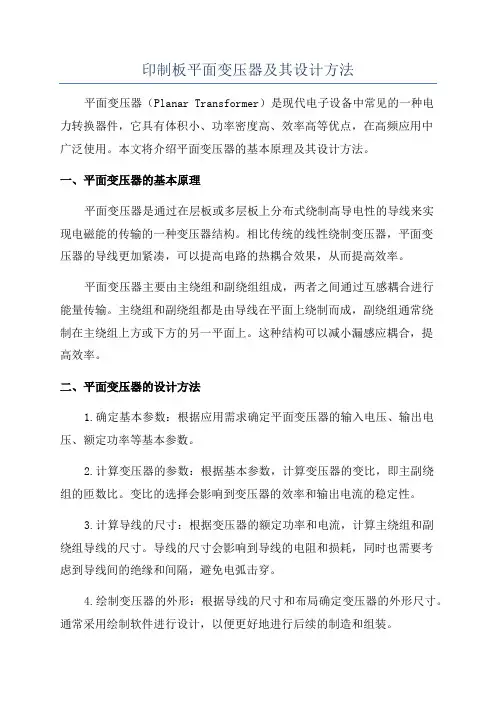
印制板平面变压器及其设计方法平面变压器(Planar Transformer)是现代电子设备中常见的一种电力转换器件,它具有体积小、功率密度高、效率高等优点,在高频应用中广泛使用。
本文将介绍平面变压器的基本原理及其设计方法。
一、平面变压器的基本原理平面变压器是通过在层板或多层板上分布式绕制高导电性的导线来实现电磁能的传输的一种变压器结构。
相比传统的线性绕制变压器,平面变压器的导线更加紧凑,可以提高电路的热耦合效果,从而提高效率。
平面变压器主要由主绕组和副绕组组成,两者之间通过互感耦合进行能量传输。
主绕组和副绕组都是由导线在平面上绕制而成,副绕组通常绕制在主绕组上方或下方的另一平面上。
这种结构可以减小漏感应耦合,提高效率。
二、平面变压器的设计方法1.确定基本参数:根据应用需求确定平面变压器的输入电压、输出电压、额定功率等基本参数。
2.计算变压器的参数:根据基本参数,计算变压器的变比,即主副绕组的匝数比。
变比的选择会影响到变压器的效率和输出电流的稳定性。
3.计算导线的尺寸:根据变压器的额定功率和电流,计算主绕组和副绕组导线的尺寸。
导线的尺寸会影响到导线的电阻和损耗,同时也需要考虑到导线间的绝缘和间隔,避免电弧击穿。
4.绘制变压器的外形:根据导线的尺寸和布局确定变压器的外形尺寸。
通常采用绘制软件进行设计,以便更好地进行后续的制造和组装。
5.选择磁芯材料:根据变压器的工作频率和功率密度选择合适的磁芯材料。
磁芯的选择会影响到变压器的磁耦合效果和磁滞损耗。
6.计算磁芯的尺寸:根据变压器的输入电压和工作频率,计算磁芯的尺寸和磁通密度。
磁芯的尺寸和磁通密度会影响到变压器的效率和磁耦合效果。
7.进行仿真和优化:使用电磁场仿真软件对设计进行模拟和优化,以改善变压器的性能,如减小漏感应耦合、降低电磁干扰等。
综上所述,平面变压器是一种高效、高密度的电力转换器件,其设计需要根据具体应用需求确定基本参数,计算变压器的参数和导线尺寸,并选择合适的磁芯材料和计算磁芯尺寸。
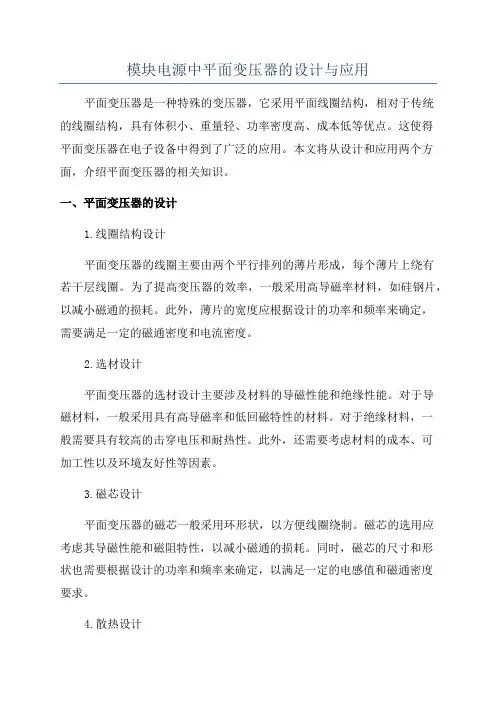
模块电源中平面变压器的设计与应用平面变压器是一种特殊的变压器,它采用平面线圈结构,相对于传统的线圈结构,具有体积小、重量轻、功率密度高、成本低等优点。
这使得平面变压器在电子设备中得到了广泛的应用。
本文将从设计和应用两个方面,介绍平面变压器的相关知识。
一、平面变压器的设计1.线圈结构设计平面变压器的线圈主要由两个平行排列的薄片形成,每个薄片上绕有若干层线圈。
为了提高变压器的效率,一般采用高导磁率材料,如硅钢片,以减小磁通的损耗。
此外,薄片的宽度应根据设计的功率和频率来确定,需要满足一定的磁通密度和电流密度。
2.选材设计平面变压器的选材设计主要涉及材料的导磁性能和绝缘性能。
对于导磁材料,一般采用具有高导磁率和低回磁特性的材料。
对于绝缘材料,一般需要具有较高的击穿电压和耐热性。
此外,还需要考虑材料的成本、可加工性以及环境友好性等因素。
3.磁芯设计平面变压器的磁芯一般采用环形状,以方便线圈绕制。
磁芯的选用应考虑其导磁性能和磁阻特性,以减小磁通的损耗。
同时,磁芯的尺寸和形状也需要根据设计的功率和频率来确定,以满足一定的电感值和磁通密度要求。
4.散热设计由于平面变压器的功率密度较高,因此散热设计非常重要。
一般可以通过增加散热片的面积、使用导热材料等方式来提高散热效果。
另外,也可以通过合理的线圈布局来提供空气流动,从而提高散热效果。
二、平面变压器的应用1.电源模块平面变压器广泛应用于各种电源模块中,如手机充电器、笔记本电源适配器等。
由于平面变压器的体积小、重量轻,非常适合于电源模块的紧凑设计。
此外,平面变压器还具有高效率、低磁声等特点,可以提高电源模块的整体性能。
2.通信设备平面变压器也被广泛应用于通信设备中,如路由器、交换机等。
通信设备对电源的稳定性和转换效率要求较高,平面变压器可以满足这些要求。
同时,平面变压器还具有高密度布局和低漏磁等特点,可以减小设备体积,提高系统的集成度。
3.汽车电子随着电动汽车的普及,平面变压器也开始在汽车电子中得到应用。

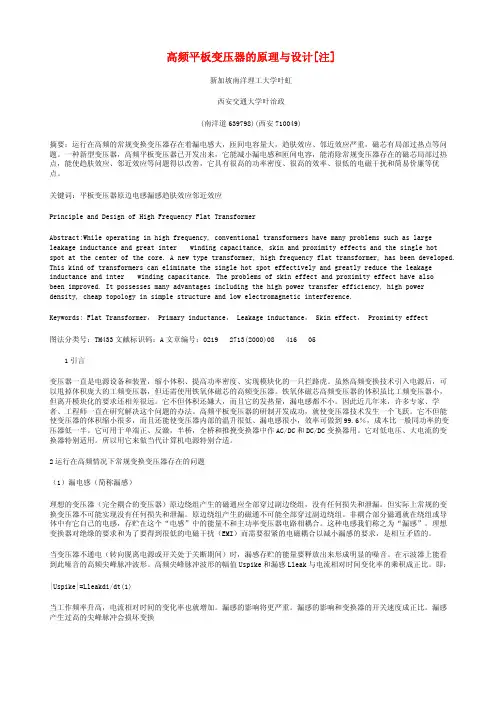
高频平板变压器的原理与设计[注]新加坡南洋理工大学叶虹西安交通大学叶治政(南洋道639798)(西安710049)摘要:运行在高频的常规变换变压器存在着漏电感大,匝间电容量大,趋肤效应、邻近效应严重,磁芯有局部过热点等问题。
一种新型变压器,高频平板变压器已开发出来,它能减小漏电感和匝间电容,能消除常规变压器存在的磁芯局部过热点,能使趋肤效应、邻近效应等问题得以改善,它具有很高的功率密度、很高的效率、很低的电磁干扰和简易价廉等优点。
关键词:平板变压器原边电感漏感趋肤效应邻近效应Principle and Design of High Frequency Flat TransformerAbstract:While operating in high frequency, conventional transformers have many problems such as large leakage inductance and great inter winding capacitance, skin and proximity effects and the single hotspot at the center of the core. A new type transformer, high frequency flat transformer, has been developed. This kind of transformers can eliminate the single hot spot effectively and greatly reduce the leakage inductance and inter winding capacitance. The problems of skin effect and proximity effect have alsobeen improved. It possesses many advantages including the high power transfer efficiency, high power density, cheap topology in simple structure and low electromagnetic interference.Keywords: Flat Transformer, Primary inductance, Leakage inductance, Skin effect, Proximity effect图法分类号:TM433文献标识码:A文章编号:0219 2713(2000)08 416 051引言变压器一直是电源设备和装置,缩小体积、提高功率密度、实现模块化的一只拦路虎。
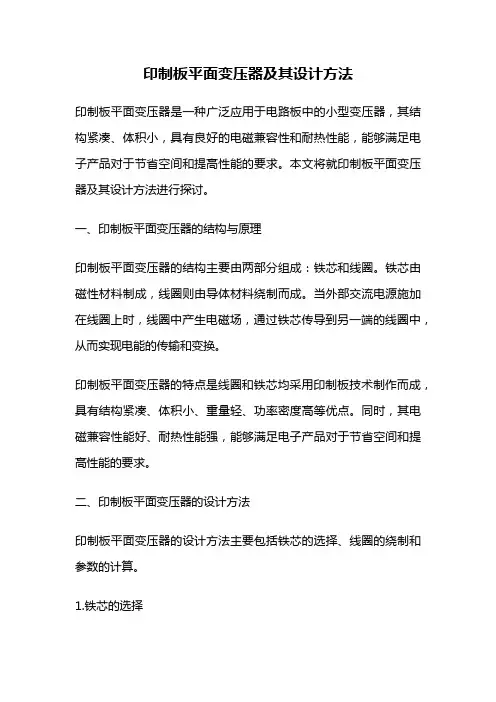
印制板平面变压器及其设计方法印制板平面变压器是一种广泛应用于电路板中的小型变压器,其结构紧凑、体积小,具有良好的电磁兼容性和耐热性能,能够满足电子产品对于节省空间和提高性能的要求。
本文将就印制板平面变压器及其设计方法进行探讨。
一、印制板平面变压器的结构与原理印制板平面变压器的结构主要由两部分组成:铁芯和线圈。
铁芯由磁性材料制成,线圈则由导体材料绕制而成。
当外部交流电源施加在线圈上时,线圈中产生电磁场,通过铁芯传导到另一端的线圈中,从而实现电能的传输和变换。
印制板平面变压器的特点是线圈和铁芯均采用印制板技术制作而成,具有结构紧凑、体积小、重量轻、功率密度高等优点。
同时,其电磁兼容性能好、耐热性能强,能够满足电子产品对于节省空间和提高性能的要求。
二、印制板平面变压器的设计方法印制板平面变压器的设计方法主要包括铁芯的选择、线圈的绕制和参数的计算。
1.铁芯的选择铁芯是印制板平面变压器的核心部件,其选择应考虑到磁导率、饱和磁感应强度、磁滞损耗、温度系数等因素。
一般采用磁性材料如硅钢片、铁氧体等制作。
2.线圈的绕制线圈的绕制是印制板平面变压器的关键步骤,其绕制方式直接影响到变压器的性能和效率。
一般采用绕线机进行绕制,绕制时应注意线圈匝数、线径、层数等参数的控制,以确保变压器的匹配度和电气性能。
3.参数的计算印制板平面变压器的参数计算包括电压比、匝数比、功率、直流电阻等参数的计算。
根据实际需求和规格要求,通过公式计算得到合适的参数值,并进行合理的调整和优化。
三、印制板平面变压器的应用领域印制板平面变压器广泛应用于电子产品中,如高频电源、通讯设备、计算机、音频设备、电视机等。
其体积小、功率密度高、电磁兼容性好等优点使其在电子产品中得到了广泛的应用。
四、印制板平面变压器的发展趋势随着电子产品的不断发展,对于印制板平面变压器的要求也越来越高。
未来,印制板平面变压器将更加注重体积的缩小、功率密度的提高、温度的控制、材料的改良等方面的发展,以满足电子产品对于高性能和节省空间的要求。
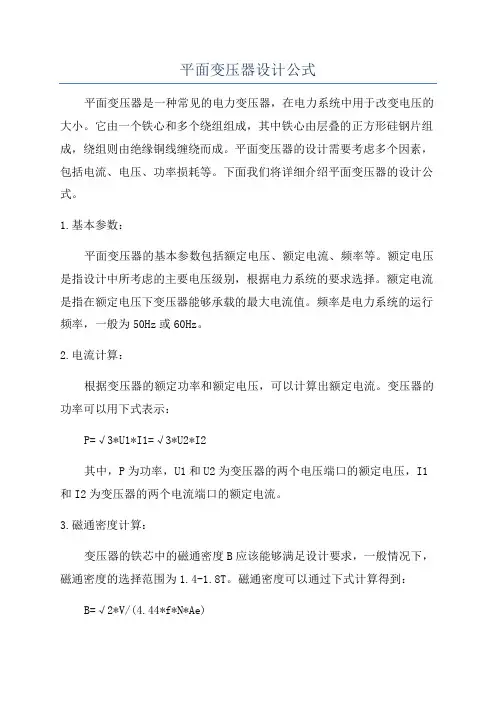
平面变压器设计公式平面变压器是一种常见的电力变压器,在电力系统中用于改变电压的大小。
它由一个铁心和多个绕组组成,其中铁心由层叠的正方形硅钢片组成,绕组则由绝缘铜线缠绕而成。
平面变压器的设计需要考虑多个因素,包括电流、电压、功率损耗等。
下面我们将详细介绍平面变压器的设计公式。
1.基本参数:平面变压器的基本参数包括额定电压、额定电流、频率等。
额定电压是指设计中所考虑的主要电压级别,根据电力系统的要求选择。
额定电流是指在额定电压下变压器能够承载的最大电流值。
频率是电力系统的运行频率,一般为50Hz或60Hz。
2.电流计算:根据变压器的额定功率和额定电压,可以计算出额定电流。
变压器的功率可以用下式表示:P=√3*U1*I1=√3*U2*I2其中,P为功率,U1和U2为变压器的两个电压端口的额定电压,I1和I2为变压器的两个电流端口的额定电流。
3.磁通密度计算:变压器的铁芯中的磁通密度B应该能够满足设计要求,一般情况下,磁通密度的选择范围为1.4-1.8T。
磁通密度可以通过下式计算得到:B=√2*V/(4.44*f*N*Ae)其中,V为变压器的额定电压,f为变压器的频率,N为变压器的绕组数,Ae为铁心有效面积。
4.铁心设计:铁心由正方形硅钢片组成,其截面积可以通过下式计算得到:Ae=√(Ki*P)/(B*f)其中,Ki为系数,一般为1.1-1.3,P为变压器的额定功率,B为磁通密度,f为频率。
5.绕组设计:绕组由绝缘铜线缠绕而成,其长度可以通过下式计算得到:L=((R1+Rc)*N+Ru)*π*d其中,R1和R2分别为绕组的外径和内径,Rc为铁心的外径,Ru为该绕组与铁心的最小厚度,N为绕组数,d为绕组的直径。
6.损耗计算:变压器的损耗主要包括铁心损耗和铜损耗。
铁心损耗可以通过下式计算得到:Pc=Ke*f*B^2*V*√2*10^(-6)其中,Ke为损耗系数,取值范围为0.2-0.3、铜损耗可以通过下式计算得到:Pcu = √3 * (I1^2 * R1 + I2^2 * R2) * 10^(-3)其中,R1和R2分别为绕组的电阻。

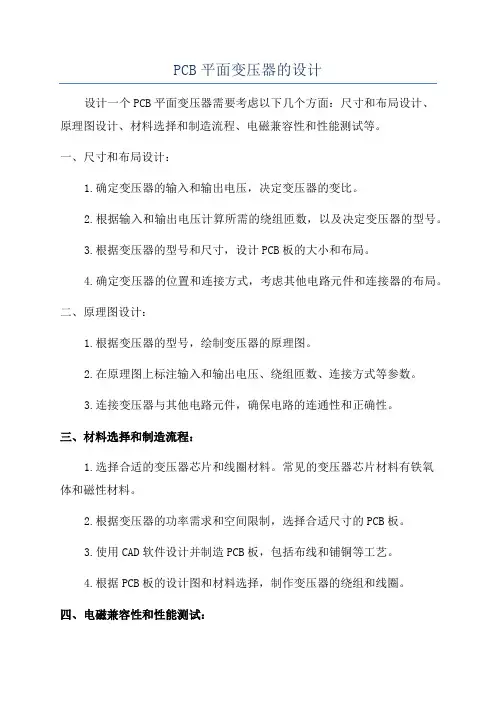
PCB平面变压器的设计
设计一个PCB平面变压器需要考虑以下几个方面:尺寸和布局设计、
原理图设计、材料选择和制造流程、电磁兼容性和性能测试等。
一、尺寸和布局设计:
1.确定变压器的输入和输出电压,决定变压器的变比。
2.根据输入和输出电压计算所需的绕组匝数,以及决定变压器的型号。
3.根据变压器的型号和尺寸,设计PCB板的大小和布局。
4.确定变压器的位置和连接方式,考虑其他电路元件和连接器的布局。
二、原理图设计:
1.根据变压器的型号,绘制变压器的原理图。
2.在原理图上标注输入和输出电压、绕组匝数、连接方式等参数。
3.连接变压器与其他电路元件,确保电路的连通性和正确性。
三、材料选择和制造流程:
1.选择合适的变压器芯片和线圈材料。
常见的变压器芯片材料有铁氧
体和磁性材料。
2.根据变压器的功率需求和空间限制,选择合适尺寸的PCB板。
3.使用CAD软件设计并制造PCB板,包括布线和铺铜等工艺。
4.根据PCB板的设计图和材料选择,制作变压器的绕组和线圈。
四、电磁兼容性和性能测试:
1.在设计过程中考虑电磁兼容性,采取一些措施来减少变压器对其他电路元件的干扰。
2.进行性能测试,包括输入输出电压的稳定性、工作温度和效率等。
以上是一个简单的PCB平面变压器设计的基本流程,不同的应用场景和要求可能会有所不同。
在实际设计过程中,还需要考虑其他因素,如成本、散热和安全性等。
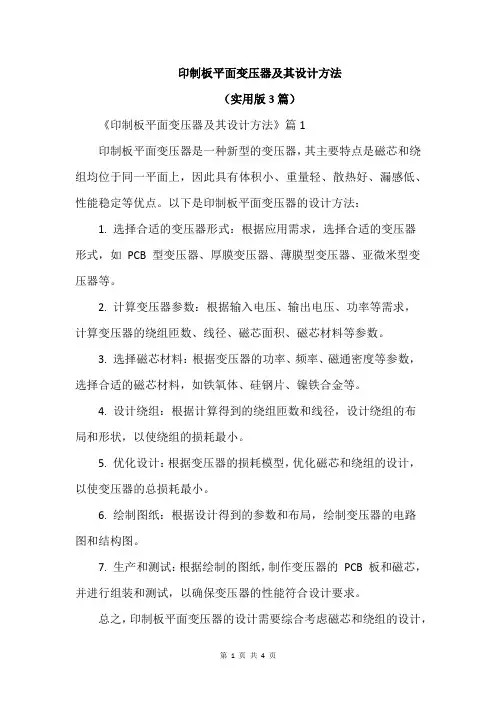
印制板平面变压器及其设计方法(实用版3篇)《印制板平面变压器及其设计方法》篇1印制板平面变压器是一种新型的变压器,其主要特点是磁芯和绕组均位于同一平面上,因此具有体积小、重量轻、散热好、漏感低、性能稳定等优点。
以下是印制板平面变压器的设计方法:1. 选择合适的变压器形式:根据应用需求,选择合适的变压器形式,如PCB 型变压器、厚膜变压器、薄膜型变压器、亚微米型变压器等。
2. 计算变压器参数:根据输入电压、输出电压、功率等需求,计算变压器的绕组匝数、线径、磁芯面积、磁芯材料等参数。
3. 选择磁芯材料:根据变压器的功率、频率、磁通密度等参数,选择合适的磁芯材料,如铁氧体、硅钢片、镍铁合金等。
4. 设计绕组:根据计算得到的绕组匝数和线径,设计绕组的布局和形状,以使绕组的损耗最小。
5. 优化设计:根据变压器的损耗模型,优化磁芯和绕组的设计,以使变压器的总损耗最小。
6. 绘制图纸:根据设计得到的参数和布局,绘制变压器的电路图和结构图。
7. 生产和测试:根据绘制的图纸,制作变压器的PCB 板和磁芯,并进行组装和测试,以确保变压器的性能符合设计要求。
总之,印制板平面变压器的设计需要综合考虑磁芯和绕组的设计,以达到损耗小、性能优的目标。
《印制板平面变压器及其设计方法》篇2印制板平面变压器是一种新型的变压器,其主要特点是磁芯和绕组均采用印刷电路板(PCB)技术制作。
由于磁芯和绕组均为平面结构,因此印制板平面变压器具有体积小、重量轻、散热性好、漏感低、性能稳定等优点。
以下是印制板平面变压器的设计方法:1. 选择变压器形式:根据应用需求,选择合适的变压器形式,如PCB 型变压器、厚膜变压器、薄膜型变压器、亚微米型变压器等。
2. 选择磁芯材料和绕组材料:根据变压器的功率、电压、电流等参数,选择合适的磁芯材料和绕组材料,如铁氧体磁芯、铜箔、铝箔等。
3. 设计绕组:根据变压器的电压比和功率需求,设计合适的绕组比和绕组匝数,并计算绕组电阻和漏感。
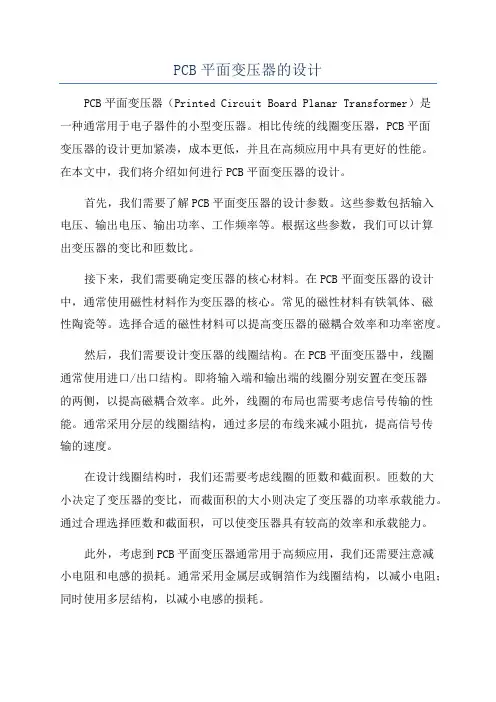
PCB平面变压器的设计PCB平面变压器(Printed Circuit Board Planar Transformer)是一种通常用于电子器件的小型变压器。
相比传统的线圈变压器,PCB平面变压器的设计更加紧凑,成本更低,并且在高频应用中具有更好的性能。
在本文中,我们将介绍如何进行PCB平面变压器的设计。
首先,我们需要了解PCB平面变压器的设计参数。
这些参数包括输入电压、输出电压、输出功率、工作频率等。
根据这些参数,我们可以计算出变压器的变比和匝数比。
接下来,我们需要确定变压器的核心材料。
在PCB平面变压器的设计中,通常使用磁性材料作为变压器的核心。
常见的磁性材料有铁氧体、磁性陶瓷等。
选择合适的磁性材料可以提高变压器的磁耦合效率和功率密度。
然后,我们需要设计变压器的线圈结构。
在PCB平面变压器中,线圈通常使用进口/出口结构。
即将输入端和输出端的线圈分别安置在变压器的两侧,以提高磁耦合效率。
此外,线圈的布局也需要考虑信号传输的性能。
通常采用分层的线圈结构,通过多层的布线来减小阻抗,提高信号传输的速度。
在设计线圈结构时,我们还需要考虑线圈的匝数和截面积。
匝数的大小决定了变压器的变比,而截面积的大小则决定了变压器的功率承载能力。
通过合理选择匝数和截面积,可以使变压器具有较高的效率和承载能力。
此外,考虑到PCB平面变压器通常用于高频应用,我们还需要注意减小电阻和电感的损耗。
通常采用金属层或铜箔作为线圈结构,以减小电阻;同时使用多层结构,以减小电感的损耗。
最后,我们需要进行变压器的封装和布局设计。
封装是保护变压器和线圈的重要部分,可以通过使用合适的外壳来提高变压器的耐压性能。
而布局设计则需要考虑信号传输的路径、散热等因素。
合理的布局设计可以提高变压器的整体性能和可靠性。
总的来说,PCB平面变压器的设计需要考虑多个因素,包括变压器的参数选择、核心材料、线圈结构、封装和布局设计等。
通过合理的设计,可以使得PCB平面变压器具有高效、紧凑和可靠的特性。
![平面变压器的特性及标准化设计(精)[推荐五篇]](https://uimg.taocdn.com/1a1dcd54dcccda38376baf1ffc4ffe473368fd22.webp)
平面变压器的特性及标准化设计(精)[推荐五篇]第一篇:平面变压器的特性及标准化设计(精)平面变压器的特性及标准化设计0 引言磁性元件的设计是开关电源的重要部分,因为平面变压器在提高开关电源的特性方面有着很大的优势,因此近年来得到了广泛的应用。
对于一个理想的变压器来说,初级线圈所产生的磁通都穿过次级线圈,即没有漏磁通。
而对普通变压器来说,初级线圈所产生的磁通并非都穿过次级线圈,于是就产生了漏感,电磁耦合的紧密要求也无法满足。
而平面变压器只有一匝网状次级绕组,这一匝绕组也不同于传统的漆包线,而是一片铜皮,贴绕在多个同样大小的冲压铁氧体磁芯表面上。
所以,平面变压器的输出电压取决于磁芯的个数,而且平面变压器的输出电流可以通过并联进行扩充,以满足设计的要求。
因此,平面变压器的特点就显而易见了:平面绕组的紧密耦合使得漏感大大地减小;平面变压器特殊的结构使得它的高度非常的低,这使变换器做在一个板上的设想得到实现。
但是,平面结构存在很高的容性效应等问题,大大限制了它的大规模使用,不过,这些缺点在某些应用中,也有可能转换为一种优点。
另外,平面的磁芯结构增大了散热面积,有利于变压器散热。
1插入技术插入技术是指在布置变压器原、副边绕组时,使原边绕组与副边绕组交替放置,增加原、副边绕组的耦合以减小漏感,同时使得电流平均分布,减小变压器损耗。
现在插入技术的研究被分为两个方面,即应用于变压器的插入(正激电路)和应用于连接电感器的插入(反激电路)。
因此,插入技术现在已经被放在不同的拓扑中作为不同的磁性部件来研究。
1.1 应用于平面变压器的插入技术应用于变压器中的插入技术的主要优点如下:1)使变压器中磁性能量储存的空间减少,导致漏感的减少;2)使电流传输过程中在导体上理想分布,导致交流阻抗的减少;3)绕组间更好的耦合作用,导致更低的漏感。
1.2在不同拓扑中平面变压器的作用在不同的拓扑中,磁性元件的作用也是不同的。
在正激变换器中的变压器,磁性能量在主开关管开通的时候由初级绕组传递到次级绕组中。
基于平板变压器的大功率密度电源设计引言:近年来,随着电子设备的普及和功能的提升,人们对于电源的需求越来越高。
其中,大功率密度电源作为一种能提供高功率输出并具有小尺寸、高效率、低重量等特点的电源设备,广泛应用于无线充电、电动车、通信设备等领域。
本文将从平板变压器的原理出发,详细介绍基于平板变压器的大功率密度电源的设计。
一、平板变压器的原理平板变压器是一种轻便、高效的电源变压器,其原理基于电磁感应定律。
平板变压器包括主线圈和副线圈,其中主线圈通常由高导磁材料制成,副线圈与主线圈之间通过磁场相互耦合。
当主线圈中通入交流电时,产生的交变磁场会在副线圈中感应出电势差,从而实现电能的传输和变压。
平板变压器相比传统变压器有着更小的尺寸和更高的效率,特别适用于大功率密度电源的设计。
二、大功率密度电源的设计要点1. 选择适合的平板变压器在设计大功率密度电源时,选择适合的平板变压器是非常重要的。
首先要考虑变压器的功率容量,根据设备的功率需求选择合适的变压器。
其次要考虑变压器的效率和工作频率。
高效率的变压器能提高电源的整体效率,而合适的工作频率则能减小变压器的体积和重量。
2. 优化电源拓扑结构电源拓扑结构对于大功率密度电源的性能也有很大影响。
常见的电源拓扑结构包括全桥变换器、半桥变换器和扁平丝卷式变换器等。
根据功率密度的要求选择合适的拓扑结构,并通过合理的电路设计和元器件选取来优化电源性能。
3. 散热设计与保护措施在设计大功率密度电源时,散热是一个必须要考虑的问题。
因为功率密度高,电源在工作中会产生大量热量,如果不进行良好的散热设计,不仅会影响电源的工作稳定性,还可能导致元器件过热甚至烧坏。
因此,在设计过程中要注意合理布局散热器、选择合适的散热材料,以及采取必要的保护措施,如过温保护、过流保护等。
三、大功率密度电源设计实例以无线充电设备为例,设计一个基于平板变压器的大功率密度电源。
1. 确定功率需求和工作频率根据设备的功率需求确定电源的功率容量,如500W。
基于平板变压器的高频谐振电源设计高频谐振电源是一种常用于电子设备的电源设计方案,其主要优势包括高效率、小尺寸和低功耗。
在高频谐振电源的设计中,平板变压器扮演着关键的角色。
本文将针对基于平板变压器的高频谐振电源的设计进行详细介绍和分析。
首先,我们来了解一下平板变压器的基本原理。
平板变压器是一种特殊的电感器件,由两个或更多的一组绕组组成,这些绕组位于一条铁芯上。
平板变压器通常在高频谐振电源设计中使用,因为其结构紧凑,可以在小尺寸的空间中实现高效的能量传递。
平板变压器的主要优势包括低电感损耗、低漏电感和低谐波失真等特性。
在进行高频谐振电源设计时,首先需要确定系统的输入和输出要求。
输入电压范围、输出电压、输出电流以及功率效率都是必须考虑的因素。
同时,还需要确定使用的开关器件和谐振频率等参数。
其次,根据系统的需求和参数确定平板变压器的设计参数。
平板变压器的设计包括主、副绕组的匝数、绕组的材质和铁芯的尺寸等。
这些参数的选择将直接影响到系统的电路性能和效率。
为了保证高效的能量传递和减小功耗,平板变压器的铁芯材料选择十分重要。
常用的铁芯材料有磁性材料和非磁性材料。
磁性材料具有高导磁性和低磁滞性,能够有效减小电能损耗。
非磁性材料则可以减小铁芯的尺寸和重量,提高系统的紧凑性。
为了进一步提高系统的效率,可以使用谐振电路来实现能量的高效传递。
高频谐振电源常常采用串联谐振电路,包括电容、电感和共振电容等元件的组合。
在谐振状态下,能量在谐振电路中多次来回传递,从而实现高效能量转换。
此外,还需要选择合适的开关器件。
常用的开关器件包括MOSFET和IGBT等。
这些器件具有低导通电阻和高开关速度等特点,能够提供较高的系统效率。
设计完成后,需要进行系统的调试和优化。
通过实际测试和测量,可以进一步优化平板变压器的设计参数和电路拓扑。
在调试过程中,需要注意避免过大的开关损耗和过高的温度,以确保系统的稳定性和可靠性。
最后,需要进行一系列的电路保护措施。
平板变压器的容量评估与设计原则研究概述本文将研究平板变压器的容量评估与设计原则。
平板变压器是一种常用的电力传输设备,用于变换交流电压的特性。
因此,准确评估和合理设计平板变压器的容量是至关重要的。
本文将从容量评估的方法、容量设计的原则以及影响容量评估与设计的因素等方面进行探讨。
一、容量评估的方法1.根据负载容量评估的方法之一是根据负载来确定变压器的容量。
根据负载评估的方法是根据负载功率来计算变压器的容量大小。
可以通过测量负载的功率需求,确定变压器的额定容量。
这种评估方法较为简单,但仅能适用于负载功率需求变化不大或比较稳定的情况。
2.根据过载容量评估的另一种方法是根据过载考虑来确定变压器的容量。
根据过载考虑的方法是考虑负载瞬时的过载情况,以保证变压器在瞬时过载情况下能够正常工作。
通过分析负载的瞬时功率需求,确定变压器的容量。
这种评估方法更为全面,但对负载波动较大的情况需要进行更加深入的分析。
3.根据热稳定性容量评估的第三种方法是根据变压器的热稳定性来确定容量。
根据热稳定性评估的方法是基于变压器的绝热特性,以确保变压器能够在长时间运行时保持稳定工作。
通过热稳定性分析,确定变压器的容量。
这种评估方法较为复杂,但对于长时间运行特性较为关键的应用场景尤为重要。
二、容量设计的原则1.安全因素容量设计的一个重要原则是考虑安全因素。
变压器在工作时会产生热量,因此必须确保变压器的容量足够以承受负载的功率需求,并且具备一定的过载能力。
安全因素的考虑可以保证变压器在正常负载和临时过载情况下能够安全工作。
2.经济性容量设计的另一个原则是考虑经济性。
变压器的容量过大会导致不必要的成本,而容量过小则可能无法满足负载需求。
因此,需要根据负载特点和成本考虑来确定合适的容量。
经济性的考虑可以保证变压器在满足负载需求的同时,减少不必要的资源浪费。
3.效率容量设计的第三个原则是考虑变压器的效率。
变压器的效率与其容量密切相关,容量过大或过小都可能导致效率下降。
基于平板变压器的高精度功率测量装置设计随着工业领域对电能测量的需求日益增长,高精度功率测量装置的设计变得尤为重要。
基于平板变压器的高精度功率测量装置是一种在工业应用中广泛使用的电能测量方案。
本文将详细介绍基于平板变压器的高精度功率测量装置的设计原理、关键技术和实现方法。
1. 设计原理基于平板变压器的高精度功率测量装置的设计基于电能守恒定律。
其核心原理是基于平板变压器的电能变换以及功率计算方法。
平板变压器通过将电能的传递实现在输入和输出之间的电流和电压之间的相对值变换。
由此,可以计算出电流和电压之间的相对相位差,进而计算功率值。
2. 关键技术(1)平板变压器设计:平板变压器的设计是基于其电能变换功能。
设计过程中,需要考虑变压器的尺寸、感应线圈的匝数、磁芯材料等因素。
尺寸和匝数的选择与输入和输出的电压和电流有关。
同时,选择高性能磁芯材料可以提高变压器的效率和精度。
(2)电流和电压测量:在功率测量装置中,电流和电压的准确测量是必不可少的。
可选择使用宽带电流互感器和电压传感器来实现电流和电压的测量。
这些传感器需要具有高稳定性和高精度,并且能够满足高精度功率测量的要求。
(3)功率计算:通过测量的电流和电压值,以及它们之间的相位差,可以计算出功率值。
功率计算可以使用数字信号处理(DSP)芯片或者专用功率计算芯片来实现。
在计算过程中,还需要考虑校正因素,例如变压器的损耗、噪声等,以提高功率测量的精度和准确性。
3. 实现方法基于平板变压器的高精度功率测量装置可以分为硬件设计和软件设计两个部分。
(1)硬件设计:硬件设计包括平板变压器的设计、电流和电压传感器的选型和电路的设计。
在平板变压器的设计过程中,需要选择合适的材料和尺寸,并进行仿真和优化。
电流和电压传感器的选型需要根据需求选择合适的规格和性能指标。
设计过程中需要充分考虑电路的抗干扰能力和环境适应性,以确保测量结果的准确性和可靠性。
(2)软件设计:软件设计主要包括信号处理算法的设计和功率计算的实现。
基于平板变压器的无线电能传输系统设计无线电能传输是一种新兴的技术应用,它通过无线电波实现电能的传输,摆脱了传统有线电源连接的限制,极大地方便了电子设备的使用。
平板变压器是无线电能传输中常用的一种技术,它可以将电能从一个电源传输到另一个电子设备上。
本文将重点介绍基于平板变压器的无线电能传输系统的设计。
第一部分:无线电能传输系统原理介绍在介绍系统设计之前,我们先来了解一下无线电能传输系统的原理。
无线电能传输系统主要由两个部分组成:传输端和接收端。
传输端通过电源提供电能,并将其传输到接收端。
传输过程中,需要一个变压器来将电能转换为无线电波,并通过无线电波进行传输。
接收端则通过另一个变压器,将无线电波再次转换成电能,并供给设备使用。
第二部分:平板变压器的设计与原理平板变压器是无线电能传输系统中的关键部分,它负责将电能转换为无线电波并进行传输。
平板变压器由两个互相绝缘的平行板构成,中间有磁场穿过,从而产生能量耦合。
平板变压器的设计需要考虑功率传输效率、距离限制以及适用的频率范围等因素。
为了提高功率传输效率,可以采用谐振方式进行频率匹配。
第三部分:无线电能传输系统的设计流程无线电能传输系统的设计需要经过以下几个步骤:1. 确定设计的目标和需求,包括传输功率、传输距离、频率范围等。
2. 设计传输端的电源和平板变压器,并考虑功率传输效率。
3. 设计接收端的平板变压器和能量接收电路,并进行功率管理。
4. 进行系统仿真和实验验证,调整设计参数以优化系统性能。
5. 进行系统的优化和改进,提高功率传输效率和传输距离。
第四部分:无线电能传输系统的应用与未来发展无线电能传输系统的应用非常广泛,可以用于电子设备的无线充电,如智能手机、笔记本电脑、智能手表等。
此外,无线电能传输系统还可以应用于电力传输、无人机充电、电动汽车充电等领域。
随着无线电能传输技术的不断发展和成熟,未来还将出现更多的应用场景和创新。
结论基于平板变压器的无线电能传输系统具有许多优点,如方便、高效、可靠等。
电子变压器中的平板变压器应用研究随着电子技术的不断发展,电子变压器已经成为现代电力系统中不可或缺的组成部分。
平板变压器作为一种新型的电子变压器,由于其结构简单、体积小、重量轻等特点,在各种电子设备和系统中得到广泛应用。
本文将对电子变压器中的平板变压器的应用进行研究,探讨其工作原理、特点及应用范围。
一、平板变压器的工作原理平板变压器是一种使用铁芯和线圈来实现电能转换的电子变压器。
其工作原理基于法拉第电磁感应定律,通过改变输入端线圈和输出端线圈的匝数比例,实现输入电压到输出电压的转换。
平板变压器的铁芯通常采用电工硅钢片制成,以减小磁阻和磁损耗。
线圈则由绝缘导线绕制而成,通过绕制在铁芯上,形成输入端线圈和输出端线圈。
当输入端线圈通入交流电时,通过电流的变化在铁芯中产生变化的磁场,从而在输出端线圈中诱导出相应的电动势。
根据线圈匝数比例,输出端线圈的电压可以比输入端线圈的电压高或低。
二、平板变压器的特点1. 结构简单:平板变压器的结构相对于传统的变压器来说更为简单,仅由铁芯和线圈组成。
由于无需复杂的绝缘层和绕组的处理,制造成本较低。
2. 体积小、重量轻:平板变压器的结构紧凑,体积小且重量轻,适用于需要大量电压转换的场合,如电子设备和通信系统。
3. 效率高:平板变压器的铁芯材料和线圈设计使其具有低损耗和高效率的特点,能够有效地提供稳定的电压输出。
4. 高频性能好:平板变压器能够在高频范围内工作,具有较高的频率响应能力,适用于一些对频率变化敏感的应用,如通信设备和无线电设备。
5. 可调性强:通过改变输入端线圈和输出端线圈的匝数比例,可以灵活地调整输出电压的大小,满足不同系统对电压变换的需求。
三、平板变压器的应用范围1. 电子设备:平板变压器广泛应用于各种电子设备中,如手机、平板电脑、电视等。
其小巧的体积和轻量级的特点使得电子设备更加便携和便于携带。
2. 通信系统:通信设备中经常需要进行多级的电压变换,平板变压器由于其高效率和高调节性能,在通信系统中得到广泛应用。
Design of PlanarPo wer T ransfo rmersContentsIntroduction 3Design procedure4Design examples-flyback8-forward 10Formulas13Layer design141FerroxcubeExploded view of a planar transformer2Ferroxcube3 FerroxcubeT able 1: Fit parameters to calculate the power loss density4Ferroxcube3. Determination of temperature rise in the PCB caused by the currentsThe final step is to check the temperature rise in the copper tracks induced by the currents. For this purpose the effective (= RMS) currents have to be calculated from the input data and desired output. The calculation method depends on the topology used. In the design examples this is shown for a conventional standard forward and flyback converter topology. An example of relations between the RMS currents and induced temperature rises for various cross sections of conductors in PCBs is shown in fig. 2. For single conductor applications or inductors which are not too closely spaced this chart can be used directly for determining conductor widths, conductor thickness, cross sectional areas and allowed maximum currents for various preset values of the temperature rise.Note:For groups of similar parallel inductors, if closely spaced, the temperature rise may be found by using an equivalent cross section and equivalent current. The equivalent cross section is the sum of the cross sectionsof the parallel conductors and the equivalent current is the sum of the currents in the inductor.A shortcoming in this design approach is that the induced heat in the windings is assumed to be caused by a DC current while in reality there is an AC current causing skin effect and proximity effect.The skin effect is the result of the magnetic field inside a conductor generated by the conductors own current. Fast current changes (high frequency) induce alternating fluxes which cause eddy currents. These eddy currents which add to the main current are opposite to the direction of the main current. The current is cancelled out in the centre of the conductor and moves towards the surface. The current density decreases exponentially from the surface towards the centre.The skin depth δ is the distance from the conductor surface towards the centre over which the current density has reduced by a factor of 1/e. The skin depth depends on material properties as conductivity and permeability and is inversely proportional to the square root of the frequency. For copper at 60 °C the skin depth can be approximated by: δ(µm) = 2230/(f [kHz])1/2 .When the conductor width (w t ) is taken smaller than 2δ, the contribution of this effect will be limited.This means a track width of <200 µm for a frequency of 500 kHz.If there is more winding width b w available for the concerned number of turns, the best solution from the magnetic point of view would be to split them up in parallel tracks.In practical situations there will be eddy current effects in the conductor not only due to the alternating field of its own current (skin effect) but also due to the fields of other conductors in the vicinity. This effect is calledthe proximity effect. When the primary and secondary layers are sandwiched this effect will be strongly decreased. Reason is that the primary and secondary currents flowin opposite directions so that their magnetic fields will cancel out. However there will still be a contribution to the proximity effect of the neighbouring conductors in the same layer.Empirical toolTemperature measurements on several designs of multilayer PCBs with AC currents supplied to the windings, show with reasonable accuracy that up to 1MHz each increaseof 100 kHz in frequency gives 2 °C extra in temperature rise of the PCB compared to the values determined for DC currents.Ferroxcube6Fig.2 Relation between current, dimensions of tracks in PCBs and temperature rise.7Ferroxcube8 FerroxcubeDepending on the heat generated by the currents the Array choice can be made between 35 or 70 µm copper layers. Between primary and secondary layers a distance of 400µm is required for the mains insulation. An E-PLT 18 combination has a minimum winding window of 1.8.mm. This is sufficient for the 35 µm layer design which results ina PCB thickness of about 1710 µm.To achieve a economic design we assumed a spacingof 300 µm between the tracks. Calculating the track widthfor the secondary winding with [5] returns 1.06 mm, inclusive mains insulation.Looking in fig 2. and using the calculated (see table 2) secondary RMS current of 1.6 A, results in a temperaturerise of 25 °C for the 35 µm layers and approx. 7 °C forthe 70 µm design.The temperature rise caused by the winding loss is allowedto be about half the total temperature rise, in this case17.5 °C. Clearly the 35 µm layers will give a too large temperature rise for an RMS current of 1.6 A and the70 µm layers will have to be used.The track widths for the primary winding turns can be calculated with [5] and will be approx. 416 µm. This track width will cause hardly any temperature rise by the primary RMS current of 0.24 A.Because the frequency is 120 kHz, 2 °C extra temperaturerise of the PCB is expected compared to the DC current situation. The total temperature rise of the PCB caused bythe currents only will remain below 10 °C.This design with 6 layers of 70 µm Cu tracks shouldfunction within its specification. The nominal thicknessof the PCB will be about 1920 µm which means that a standard planar E-PLT18 combination cannot be used.The standard E-E18 combination with a winding windowof 3.6 mm is usable. However its winding window is excessive, so a customized core shape with a windingwindow of approximately 2 mm would be a more elegant solution.Measurements on a comparable design with an E-E core combination in 3C90 material showed a total temperaturerise of 28 °C. This is in line with a calculated contributionof 17.5 °C temperature rise from the core losses and 10 °C caused by winding losses.The coupling between primary and secondary is good because the leakage inductance turns out to be only0.6 % of the primary inductance.9FerroxcubeReferences1. Mulder S.A., 1990Application note on the design of low profile high frequency transformers, Ferroxcube Components.2. Mulder S.A.,1994Loss formulas for power ferrites and their use in transformer design,Philips Components.3. Durbaum Th, Albach M, 1995Core losses in transformers with an arbitrary shape of the magnetizing current.1995 EPE Sevilla.4. Brockmeyer A., 1995Experimental Evaluation of the influence of DC premagnetization on the properties of power electronic ferrites, Aachen University of T echnology5. Ferroxcube Components technical note, 199625 Watt DC/DC converter using integrated Planar Magnetics.(9398 236 26011)Appendix 1: Formulas used for the calculations of the designformulas for flyback transformers formulas for forward transformersAppendix 2: Layer design for the planar E 14 forward transformerTop view of the example multilayer PCB。